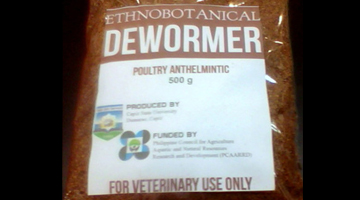 A study showed that the use of combined formulated ethnobotanical anthelmintic, specifically 2 g/kg body weight of formulated Ipil-ipil and betel nut, was most effective in treating roundworms of Darag native chicken.
A study showed that the use of combined formulated ethnobotanical anthelmintic, specifically 2 g/kg body weight of formulated Ipil-ipil and betel nut, was most effective in treating roundworms of Darag native chicken.
Titled “Production and distribution of ethnobotanical anthelmintics for free-range native chicken”, the study was conducted by researchers of the Capiz State University (CapSU).
Results also showed that the ethnobotanical anthelmintic has a comparable effect with the commercial dewormer.
To arrive at the results, the efficacy of the ethnobotanical dewormer was monitored and evaluated based on the reduction of worms (egg per gram count). Regular monitoring was done in the different sub-stations of the project located at CapSU, West Visayas State University, Aklan State University, and in a cooperator’s farm.
Fecalysis was done before and after the administration of the combined ethnobotanical dewormer. It was noted that there was a very high percent reduction of internal parasites egg per gram count from the different substations.
The study was conducted to address the problem of the prevalence of internal parasitism in native chickens, which is considered a major constraint in livestock production.
The high cost of commercial veterinary anthelmintics and its unavailability at the barangay level also prompted researchers to conduct the study. Furthermore, birds which rely entirely on commercial dewormers are also threatened by widespread occurrence of drug resistance.
With the use of available ethnobotanicals in a locality, the parasitic burden can be reduced to tolerable levels. These plants contain potential constituents that can serve as cheap sources of anthelmintics to complement the commercially manufactured parasitic drugs.
Currently, 103,000 doses (206 kg) of ethnobotanical anthelmintic were already produced and introduced in the market. Of these, 60,685 doses or 121.37 kg were distributed and sold to farmers in Aklan, Iloilo, Negros Occidental, and in Regions 5, 7, and 9.
The study on production and distribution of ethnobotanical anthelmintics for free-range native chickens was awarded as second Best Development Paper during the National Symposium on Agriculture and Aquatic Resources Research and Development on October 28, 2014 at Elvira O. Tan Hall, PCAARRD Headquarters, Los Banos, Laguna.
Initiated by the Los Baños-based PCAARRD, the NSAARRD recognizes the outstanding contributions of individuals and organizations in uplifting the state of research and development in the country, particularly in the agriculture, aquatic, and natural resources sectors.
Recognition focuses on the research and development outputs that fuel the Council to address its task in providing science-based know-how and tools that will enable the agricultural and aquatic sectors to raise productivity to world-class standards.
